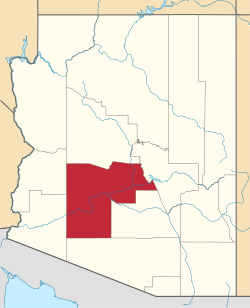Fictional Apache Wells
In fiction, particularly in Western movies, "Apache Wells" is a common name for a fictional location in the Old West, generally a remote stagecoach way station, typically in southern Arizona. It first came into conspicuous public use in John Ford's classic 1939 western movie Stagecoach, [2] the film that elevated John Wayne to stardom. (The film also had remakes in 1966 and 1986).
Subsequent westerns set partly, or chiefly, in or around the fictional "Apache Wells" have included:
At the time that the fictional "Apache Wells" first came into use, there was not any actual town of Apache Wells in Arizona, but there were two small, remote settlements in southern Arizona with closely related names: Apache Junction, and Desert Wells — both of which had existed since the 1800s, when they had been sites of stagecoach way stations.
This page is based on this
Wikipedia article Text is available under the
CC BY-SA 4.0 license; additional terms may apply.
Images, videos and audio are available under their respective licenses.

